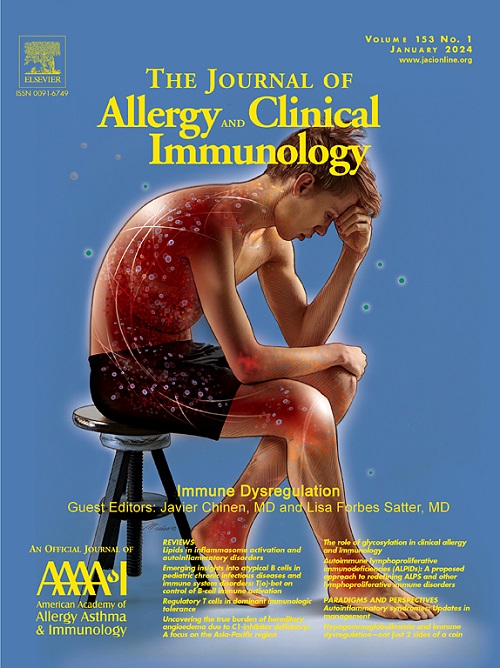Regulation of immune cell metabolism by therapeutic normal IgG intravenous immunoglobulin.
IF 11.4
1区 医学
Q1 ALLERGY
引用次数: 0
Abstract
BACKGROUND Immune cell metabolism and metabolic end-products influence the nature and magnitude of immune responses. Various autoimmune and inflammatory diseases are associated with dysregulated cellular metabolism. Intravenous immunoglobulin (IVIG), a therapeutic pooled normal IgG, is extensively used for the immunotherapy of a wide-range of autoimmune and inflammatory diseases. Although several cellular and molecular mechanisms of action of IVIG have been reported, the role of IVIG in modulating the immune cell metabolism remains unknown. OBJECTIVES To investigate the influence of IVIG on the metabolic events of human immune cells. METHODS We performed metabolic flux analyses on inflammatory mediators-stimulated human peripheral blood mononuclear cells (PBMCs). Further, intracellular metabolites were extracted from activated PBMCs and subjected to liquid chromatography coupled to high-resolution mass spectrometry. Untargeted global metabolic profiling of PBMCs was performed to determine the metabolic landscape of immune cells and metabolic reprogramming by IVIG. Targeted lipidomics was used for the mechanistic studies on IVIG-induced lipogenesis. RESULTS IVIG, and its Fc and F(ab')2 fragments regulate the Warburg effect in activated PBMCs depending on the glucose availability. Untargeted global metabolic profiling revealed that IVIG alters the overall metabolic landscape of inflammatory mediators-stimulated PBMCs, blocks prenylation of amino acid cysteine and promotes lipogenesis of well-known anti-inflammatory lipids like diacylglycerol and triacylglycerol by shuttling acetyl-CoA away from the mevalonate pathway. Mechanistically, IVIG-induced lipogenesis was mediated via F(ab')2 fragments and dependent on the sialylated glycans of IgG. CONCLUSIONS Our data indicate that IVIG targets immune cell metabolism and highlights a novel mechanism of action of IVIG in the context of immunotherapy of autoimmune and inflammatory diseases.治疗性正常IgG静脉注射免疫球蛋白对免疫细胞代谢的调节。
免疫细胞代谢和代谢终产物影响免疫反应的性质和强度。多种自身免疫性和炎症性疾病与细胞代谢失调有关。静脉注射免疫球蛋白(IVIG)是一种治疗性的正常IgG,广泛用于多种自身免疫性和炎症性疾病的免疫治疗。虽然已经报道了IVIG的一些细胞和分子作用机制,但IVIG在调节免疫细胞代谢中的作用仍然未知。目的探讨IVIG对人免疫细胞代谢事件的影响。方法对炎症介质刺激的人外周血单个核细胞(PBMCs)进行代谢通量分析。此外,从活化的pbmc中提取细胞内代谢物,并进行液相色谱耦合高分辨率质谱分析。通过IVIG对PBMCs进行非靶向全局代谢分析,以确定免疫细胞的代谢景观和代谢重编程。靶向脂质组学用于研究ivig诱导脂肪生成的机制。结果vig及其Fc和F(ab’)2片段根据葡萄糖的可用性调节活化pbmc中的Warburg效应。非靶向全球代谢分析显示,IVIG改变了炎症介质刺激的PBMCs的整体代谢景观,阻断了氨基酸半胱氨酸的戊烯酰化,并通过将乙酰辅酶a从甲羟戊酸途径中转运,促进了众所周知的抗炎脂质(如二酰基甘油和三酰基甘油)的脂肪生成。在机制上,ivig诱导的脂肪形成是通过F(ab')2片段介导的,依赖于IgG的唾液化聚糖。结论IVIG以免疫细胞代谢为靶点,在自身免疫性疾病和炎症性疾病的免疫治疗中具有新的作用机制。
本文章由计算机程序翻译,如有差异,请以英文原文为准。
求助全文
约1分钟内获得全文
求助全文
来源期刊
CiteScore
25.90
自引率
7.70%
发文量
1302
审稿时长
38 days
期刊介绍:
The Journal of Allergy and Clinical Immunology is a prestigious publication that features groundbreaking research in the fields of Allergy, Asthma, and Immunology. This influential journal publishes high-impact research papers that explore various topics, including asthma, food allergy, allergic rhinitis, atopic dermatitis, primary immune deficiencies, occupational and environmental allergy, and other allergic and immunologic diseases. The articles not only report on clinical trials and mechanistic studies but also provide insights into novel therapies, underlying mechanisms, and important discoveries that contribute to our understanding of these diseases. By sharing this valuable information, the journal aims to enhance the diagnosis and management of patients in the future.

 求助内容:
求助内容: 应助结果提醒方式:
应助结果提醒方式:


